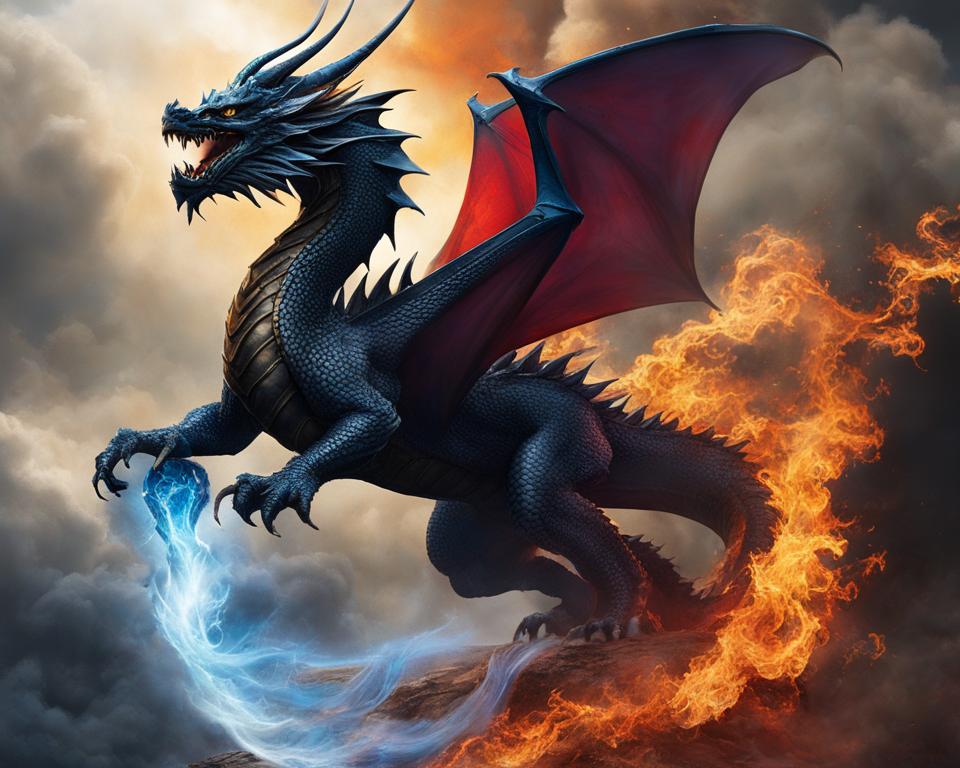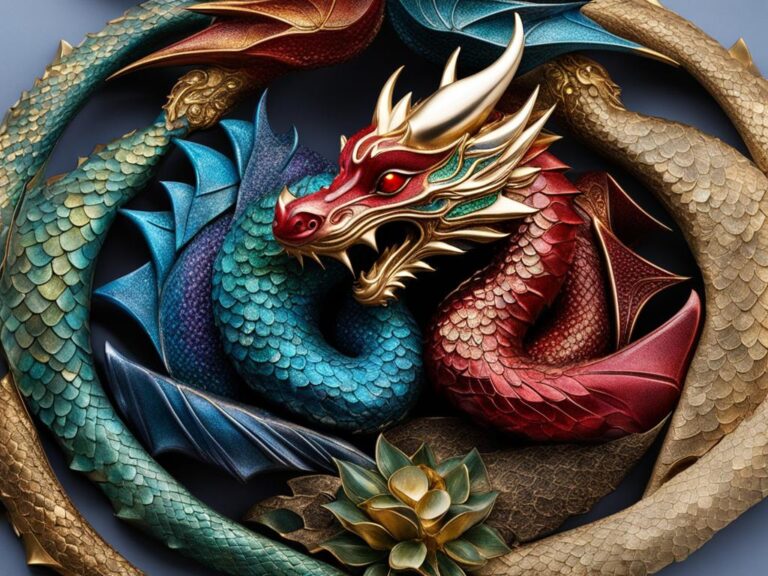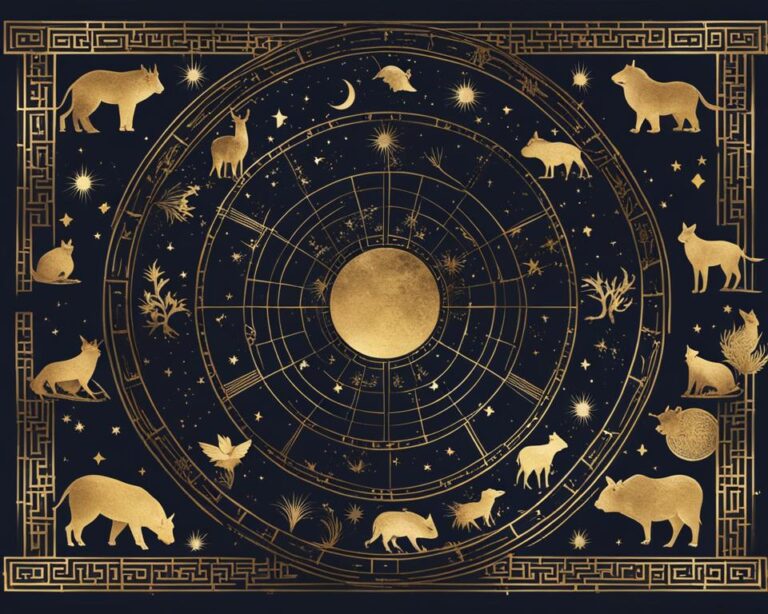The Dragon sign holds immense significance in Chinese culture, representing power, wisdom, and protection against adversaries. Its symbolism encompasses birth and the heavens, contrasting the Tiger’s association with death and earthly matters. The Dragon’s ferocity is characterized by circular and flexible combat techniques. For thousands of years, the Dragon has been an integral part of Chinese culture, with Chinese Emperors being linked to this majestic creature as far back as 3000 BC. In the realm of Kung Fu, the Dragon represents enlightenment, encouraging practitioners to adopt a circular and intellectual approach over time.
Key Takeaways:
- The Dragon zodiac sign symbolizes birth, wisdom, and protection against adversaries.
- Contrasting the Tiger, the Dragon embodies the heavens and the circle of life.
- The Dragon’s combat techniques revolve around circular and flexible movements.
- Chinese Emperors have long been associated with the Dragon, dating back to 3000 BC.
- In Kung Fu, the Dragon represents enlightenment and intellectual growth.
The Dragon Sign: Personality Traits and Compatibility
People born under the Dragon zodiac sign possess a unique set of personality traits and characteristics. They are known for their power, confidence, and charisma, making them natural-born leaders. Dragons have a strong sense of self and are always striving for success. However, they can also be impulsive and hot-tempered at times.
When it comes to compatibility, Dragons tend to get along well with Rat and Monkey signs. These signs share similar adventurous and outgoing traits, creating a harmonious dynamic. However, Dragons may clash with Dog and Rabbit signs due to differences in personalities and priorities.
To better understand the Dragon sign’s personality traits and compatibility, refer to the table below:
| Personality Traits | Compatibility |
|---|---|
| Powerful | Rat, Monkey |
| Confident | Rat, Monkey |
| Charismatic | Rat, Monkey |
| Impulsive | Dog, Rabbit |
| Hot-tempered | Dog, Rabbit |
“Dragons are powerful beings, commanding attention wherever they go. Their confidence and charisma draw people in, making them natural leaders. However, their impulsive nature can sometimes lead to clashes with more reserved signs.” – Chinese Astrologer
Understanding the Dragon sign’s personality traits and compatibility can provide valuable insights into relationships and interactions. By acknowledging both the strengths and potential challenges, individuals can navigate social dynamics more effectively and build harmonious connections.
Dragon Symbolism and Meaning
The Dragon holds deep symbolism in various cultures around the world. In Chinese culture, dragons symbolize power, strength, and good fortune. They are seen as protectors and bringers of wealth and prosperity. Dragons are often associated with the element of fire and are believed to have control over rain, storms, and natural disasters. They represent transformation and are seen as intermediaries between heaven and earth. In Western cultures, dragons are often depicted as fearsome creatures, representing chaos and destruction.
Dragons symbolize power, strength, and good fortune. They are seen as protectors and bringers of wealth and prosperity.
The Dragon sign meaning goes beyond its association with mythology and folklore. It has become an emblem of personal growth, resilience, and inner strength. People who resonate with the Dragon sign often embody these qualities in their lives. They are driven by ambition, courage, and a desire to make a positive impact. The symbolism of the Dragon serves as a reminder for individuals to tap into their own potential, embrace transformation, and unleash their inner power.
Furthermore, the Dragon’s symbolism extends to the realm of spirituality and personal development. The Dragon represents the awakening of the Kundalini energy, which is believed to lie dormant at the base of the spine. Just as the Dragon rises and soars through the skies, individuals who embrace the Dragon’s energy can experience a spiritual awakening and elevate their consciousness.
| Dragon Symbolism | Meaning |
|---|---|
| Power | Dragons symbolize immense power and strength. |
| Transformation | Dragons represent the ability to undergo profound personal transformation. |
| Protection | Dragons are often seen as protectors, shielding individuals from harm. |
| Wisdom | Dragons are associated with wisdom and enlightenment. |
| Prosperity | Dragons are believed to bring wealth and abundance. |
The Dragon Sign in Astrology
The Dragon is one of the 12 animal signs in Chinese astrology, each representing different personality traits and characteristics. People born in the year of the Dragon, which occurs every 12 years, are believed to possess distinct qualities and potential. In Chinese culture, the Dragon is associated with power, ambition, and passion.
According to astrologers, individuals born in the year of the Dragon are often ambitious and confident. They have a natural inclination towards leadership and tend to bring a sense of excitement and enthusiasm to their endeavors. With their strong intuition and creativity, Dragons are known for their ability to think outside the box and come up with innovative solutions.
However, Dragons can also be prone to arrogance and stubbornness. Their confidence and determination can sometimes border on impulsiveness, leading them to make hasty decisions. It is important for Dragons to maintain a balance between their assertiveness and receptiveness to others’ ideas and perspectives.
Dragon Zodiac Sign Traits
Here are some key traits associated with the Dragon zodiac sign:
- Powerful and confident
- Ambitious and goal-oriented
- Charismatic and captivating
- Intuitive and creative
- Impulsive and hot-tempered
Dragons are powerful and ambitious individuals who possess natural leadership qualities. They have a strong sense of self and a desire to make a mark on the world. With their intuitive nature and creative thinking, Dragons can inspire others and bring about positive change.
Understanding the Dragon sign in astrology can provide insights into one’s strengths and weaknesses. By embracing their inherent qualities and being mindful of their tendencies, individuals born under the Dragon sign can harness their potential and navigate their path to success.
Dragon Compatibility
In Chinese astrology, compatibility between zodiac signs is based on the interaction of their elements and personalities. Dragons are believed to be most compatible with Rat and Monkey signs. These signs share similar adventurous and outgoing traits, making them compatible partners in both personal and professional relationships.
On the other hand, Dragons may clash with Dog and Rabbit signs due to differences in priorities and personality traits. It is important for Dragons to understand and respect the strengths and weaknesses of their compatible and incompatible signs, fostering understanding and harmony in their relationships.
| Zodiac Sign | Compatibility |
|---|---|
| Rat | High |
| Monkey | High |
| Dog | Low |
| Rabbit | Low |
Unleashing the Dragon’s Power in Kung Fu Training
In Kung Fu, practitioners have the opportunity to tap into the formidable power of the Dragon and incorporate its essence into their training. Through specific techniques and forms such as the Dragon Form, Dragon Broad Sword, and Dragon Double Broad Sword, practitioners learn to emulate the Dragon’s circular and flexible attacks, enhancing their combat skills.
When practicing the Dragon Form, practitioners are encouraged to get low in their stances, mirroring the grounded yet agile nature of the Dragon. By aiming for high jumps, they simulate the Dragon’s fluid and swift movements. This form emphasizes the importance of circular and intellectual approaches to combat, empowering practitioners to outsmart their opponents instead of relying solely on brute force.
For those with a specialization in weapons, the Dragon Broad Sword and Dragon Double Broad Sword allow practitioners to wield these weapons with the grace and precision of the Dragon. The techniques involved in wielding these swords enhance coordination, agility, and mastery over the weapon, granting practitioners a unique advantage in combat.
| Dragon Form | Dragon Broad Sword | Dragon Double Broad Sword |
|---|---|---|
| The Dragon Form emphasizes circular and flexible attacks. | The Dragon Broad Sword technique enhances coordination and agility in wielding the weapon. | The Dragon Double Broad Sword technique grants practitioners mastery over dual-wielding swords, increasing their combat versatility. |
| Practitioners simulate the Dragon’s movements through low stances and high jumps. | By mirroring the Dragon’s grace, practitioners gain a unique advantage in combat. | The mastery of dual-wielding swords allows practitioners to surprise and overpower their opponents. |
| The form encourages intellectual approaches to combat, prioritizing outsmarting opponents. | Coordination and precision are key in maximizing the weapon’s potential. | Practitioners develop enhanced coordination and agility by mastering the art of dual-wielding. |
Embracing the Dragon’s power in Kung Fu training goes beyond physical techniques. It encompasses the cultivation of the Dragon’s qualities within oneself – wisdom, adaptability, and strategic thinking. Like the Dragon, Kung Fu practitioners are advised to use their fighting skills as a last resort, prioritizing intelligence and outmaneuvering their opponents.
Unleash Your Inner Dragon with a Meditation and Majik Class

For those seeking to tap into the mystical energy of dragons, meditation and majik classes offer a transformative experience. These classes provide an opportunity to connect with the wisdom, strength, and transformative qualities associated with dragons. Through various practices such as dragon light language, healing, and tantra, participants can awaken their inner dragon and unlock personal empowerment, spiritual growth, and manifestation in their lives.
“Meditation and majik classes allow individuals to tap into the ancient and powerful energy of dragons, enabling them to connect with their inner strength and wisdom.” – Dragon Energy Practitioner
The practice of dragon light language involves using specific sounds, tones, and symbols to communicate with the dragon energy. It is believed that this language carries the wisdom and power of dragons and can be used to manifest intentions, heal emotional wounds, and enhance personal growth. Dragon healing techniques focus on balancing and harmonizing energy centers in the body, promoting overall well-being and vitality.
Dragon tantra, on the other hand, explores the sacred and sensual aspects of the dragon energy. It involves connecting with the primal and passionate nature within, embracing pleasure, and cultivating a deeper connection with oneself and others. Through dragon tantra, individuals can explore and expand their sexual energy, unlocking new dimensions of pleasure, intimacy, and spiritual connection.
Whether you’re seeking personal transformation, spiritual growth, or manifestation of abundance, meditation and majik classes focused on dragons can provide a unique and empowering experience. By tapping into the ancient and powerful energy of the dragon, participants can unleash their inner strength, wisdom, and creativity, bringing about positive change and unlocking their hidden potential.
Dragon Meditation and Majik Class Benefits:
- Awaken your inner strength and wisdom
- Enhance spiritual growth and self-awareness
- Unlock personal empowerment and manifestation abilities
- Heal emotional wounds and promote overall well-being
- Explore a deeper connection with your own primal energy
- Cultivate pleasure, intimacy, and spiritual connection
Embarking on a meditation and majik class focused on dragons can be a profound journey of self-discovery and transformation. By embracing the power and wisdom of the dragon, individuals can tap into their true potential and create a life filled with abundance, joy, and fulfillment.
The Role of Organizational Energy in Unleashing the Dragon’s Power
Organizational energy is a vital factor in determining the success and performance of companies. It refers to the collective energy, motivation, and engagement of individuals within an organization. Research has shown that higher levels of organizational energy are strongly correlated with better company performance and innovation. Organizations with high levels of energy are more agile, adaptable, and able to navigate through challenges, resulting in improved overall outcomes.
Leaders and managers play a crucial role in shaping and channeling organizational energy. They have the power to create a positive work environment, motivate employees, and encourage collaboration. By fostering a culture of trust, communication, and empowerment, leaders can nurture the Dragon’s power within their organizations.
“Organizational energy is like the fuel that powers a Dragon’s fire. When harnessed effectively, it can ignite innovation, creativity, and high-performance,” says Dr. Emily Chang, a renowned organizational psychologist. “Leaders who understand the importance of organizational energy can tap into its potential to drive growth, adapt to change, and thrive in today’s dynamic business landscape.”
Table: Factors Influencing Organizational Energy
| Factors | Description |
|---|---|
| Leadership | Strong and empowering leadership that inspires trust, provides clear direction, and promotes a positive work culture. |
| Employee Engagement | Active involvement and commitment of employees, who feel valued, motivated, and connected to the organization’s goals. |
| Communication | Transparent and effective communication that fosters engagement, alignment, and a sense of belonging among employees. |
| Recognition and Reward | Recognition and reward systems that acknowledge and celebrate employee contributions, fostering a culture of appreciation and motivation. |
| Collaboration | Promotion of cross-functional collaboration, teamwork, and knowledge sharing, driving innovation and synergy. |
By focusing on these key factors, leaders can enhance organizational energy and unleash the Dragon’s power within their teams. This energy fuels motivation, creativity, and a positive work culture, leading to improved company performance, innovation, and ultimately, success.
Overcoming Comfort Zones and Embracing Change
Comfort zones can be a tempting place to stay, offering a sense of security and familiarity. However, to unleash the Dragon’s power within an organization, leaders must be willing to challenge these comfort zones and embrace change. It is through embracing change that companies can experience growth, innovation, and transformation.
Organizational change is essential for staying competitive and adapting to new market dynamics. By encouraging employees to step out of their comfort zones and explore new ideas and approaches, leaders can foster a culture of innovation and continuous improvement. This can lead to increased creativity, problem-solving abilities, and resilience within the organization.
Embracing change requires a willingness to let go of old ways of thinking and doing things. It involves taking risks, being open to new possibilities, and encouraging experimentation. Leaders should create an environment that supports learning and growth, where mistakes are seen as opportunities for improvement rather than failures.
“The only way to make sense out of change is to plunge into it, move with it, and join the dance.” – Alan Watts
By embracing change and challenging comfort zones, organizations can unlock hidden potential and achieve extraordinary results. It requires strong leadership, effective communication, and a commitment to learning and development. As the saying goes, “life begins at the end of your comfort zone.” So, let the Dragon’s spirit guide you in breaking free from the confines of comfort and embracing the transformative power of change.
| Benefits of Overcoming Comfort Zones and Embracing Change | Challenges of Overcoming Comfort Zones and Embracing Change |
|---|---|
|
|
Slaying the Dragon: Taking Bold Action in Times of Crisis

During times of profound trauma or crisis, it becomes essential for organizations to recognize the need for change and take bold action. These moments serve as wake-up calls, igniting a sense of urgency and prompting leaders to make necessary changes to steer their organizations in a new and transformative direction.
Effective leadership during times of crisis involves making tough decisions, rallying the team, and mobilizing resources to address the challenges head-on. It requires a deep level of resilience, adaptability, and an unwavering commitment to the organization’s mission and vision. Leaders must step up and provide guidance, stability, and reassurance to their employees, fostering a sense of unity and trust even in the face of uncertainty.
In the midst of crisis, leaders have the opportunity to harness the collective energy and creativity of their teams, encouraging collaboration and innovative thinking. By embracing new strategies, technologies, and approaches, organizations can adapt to the rapidly changing landscape and emerge stronger than ever before.
Building Resilient Leadership
In order to navigate through challenging times and lead successful organizational change, leaders must embody resilience. Resilient leaders possess the ability to remain calm under pressure, make difficult decisions with conviction, and inspire others to persevere. They understand that crisis brings both risks and opportunities, and are not afraid to take calculated risks in pursuit of positive change.
Resilient leaders also prioritize communication and transparency, providing regular updates and clear guidance to their teams. They foster an environment of open dialogue, encouraging employees to share their concerns and ideas. By maintaining strong lines of communication, leaders can build trust, boost morale, and keep the entire organization aligned and focused on common goals.
By embracing the challenges that come with crisis, leaders have the power to transform their organizations and unleash the dragon’s power within.
Empowering Employees as Dragon Allies

Employee empowerment and active participation are key factors in unleashing the Dragon’s power within an organization. When employees are empowered, they feel a sense of ownership, engagement, and commitment to their work. This leads to increased productivity, creativity, and innovation.
By providing opportunities for employees to contribute their ideas, take on new challenges, and grow professionally, leaders can tap into the unique skills, perspectives, and insights of their team members. This creates a culture of collaboration, continuous learning, and shared success.
When employees are actively involved in decision-making processes and given autonomy to make choices, they feel valued and motivated. This sense of empowerment fosters a positive work environment where individuals can thrive and reach their full potential.
Benefits of Employee Empowerment
- Increased job satisfaction and morale
- Higher levels of motivation and engagement
- Enhanced creativity and problem-solving abilities
- Improved decision-making and faster response times
- Greater accountability and ownership
- Heightened sense of loyalty and commitment
When employees are empowered, they become valuable allies in driving organizational success. They become more proactive, innovative, and adaptable, which allows the organization to stay competitive and thrive in a rapidly changing business landscape.
“Empowerment is not just about giving employees authority; it’s about creating a supportive and empowering culture where everyone’s voice is heard and valued.”
― Anonymous
| Steps to Empower Employees | Benefits |
|---|---|
| Provide clear expectations and goals | Ensure alignment and focus |
| Encourage open communication | Facilitate collaboration and knowledge sharing |
| Offer training and development opportunities | Promote continuous learning and growth |
| Delegate decision-making authority | Increase autonomy and accountability |
| Recognize and celebrate achievements | Boost morale and motivation |
Unleashing the Dragon’s Power Through Transformational Leadership

Transformational leadership, characterized by inspiring and motivating individuals to reach their full potential, plays a vital role in unleashing the power of the Dragon within organizations. This leadership style creates a sense of purpose and direction, empowering employees to contribute their unique skills and abilities towards achieving ambitious goals. By fostering a culture of trust, collaboration, and continuous learning, transformational leaders tap into the Dragon’s energy and unlock hidden potential within their teams.
Transformational leaders communicate a compelling vision that inspires and motivates employees to go beyond their comfort zones. They encourage innovation and embrace change, recognizing that organizational growth and success require adaptability and the willingness to explore new possibilities. Through effective communication, transformational leaders create a shared understanding of the need for organizational change and inspire individuals to work towards a common goal.
One of the key strengths of transformational leadership is its ability to empower employees. Transformational leaders provide opportunities for personal and professional growth, nurturing a sense of ownership and commitment among team members. They encourage active participation, seeking input and ideas from employees at all levels of the organization. This inclusive approach fosters a culture of innovation and continuous improvement, enabling the organization to navigate challenges and seize new opportunities for growth and success.
The Impact of Transformational Leadership on Organizational Change
Research has shown that transformational leadership has a significant impact on organizational change. By nurturing a culture of trust and collaboration, transformational leaders create an environment that is receptive to change and open to new ideas. They encourage employees to take risks, learn from failures, and continuously improve. This mindset of growth and adaptability allows organizations to navigate complex and dynamic environments with agility and resilience.
Furthermore, transformational leaders play a crucial role in managing the human side of change. They support employees through the challenges and uncertainties that accompany organizational change, providing guidance, reassurance, and the necessary resources. By demonstrating empathy and understanding, transformational leaders build trust and inspire confidence in the change process, facilitating successful implementation and adoption of new initiatives.
In conclusion, transformational leadership is a powerful tool for unleashing the Dragon’s power within organizations. By inspiring and motivating employees, empowering them to contribute their unique skills and ideas, and fostering a culture of trust, collaboration, and continuous learning, transformational leaders enable organizations to navigate change, adapt to new challenges, and unlock their full potential for growth and success.
Conclusion
In conclusion, the Dragon sign holds significant power and influence in various aspects of life, including astrology, martial arts, and organizational dynamics. Understanding and embracing the qualities of the Dragon can lead to personal and professional growth, empowerment, and success.
Whether it’s tapping into the Dragon’s energy through Kung Fu training, meditation and majik classes, or unleashing the Dragon’s power within an organization through effective leadership and employee empowerment, embracing the Dragon’s symbol can bring about positive transformation and unlock hidden potential.
The Dragon’s symbolism represents birth, wisdom, and standing guard against enemies, making it a powerful force in Chinese culture. Its association with ferocity, circular attacks, and enlightenment in Kung Fu further emphasizes its significance.
By harnessing the Dragon’s power, individuals and organizations can tap into its transformative qualities, creating a culture of innovation, personal empowerment, and collective success.
FAQ
What does the Dragon symbolize in Chinese culture?
The Dragon symbolizes birth, wisdom, standing guard against enemies, and embodies the heavens and the circle of life.
How long has the Dragon been a significant part of Chinese culture?
The Dragon has been a significant part of Chinese culture for thousands of years, with Chinese Emperors being associated with Dragons as early as 3000 BC.
What are the personality traits of people born under the Dragon zodiac sign?
People born under the Dragon zodiac sign are known for their power, confidence, charisma, courage, ambition, and can also be impulsive and hot-tempered at times.
Which zodiac signs are compatible with the Dragon sign?
The Dragon sign gets along well with Rat and Monkey signs, but may clash with Dog and Rabbit signs.
What does the Dragon symbolize in different cultures?
In Chinese culture, dragons symbolize power, strength, good fortune, protection, and transformation. In Western cultures, dragons are often depicted as fearsome creatures representing chaos and destruction.
What is the Dragon’s significance in Chinese astrology?
In Chinese astrology, the Dragon is one of the 12 animal signs associated with ambitious, confident, passionate individuals who are natural-born leaders and tend to be successful in their careers.
How can Kung Fu practitioners incorporate the Dragon’s power into their training?
Kung Fu practitioners can learn from the Dragon’s circular, flexible attacks and emulate them through techniques and forms such as the Dragon Form, Dragon Broad Sword, and Dragon Double Broad Sword.
Are there classes available to tap into the energy of dragons?
Yes, there are meditation and majik classes available that aim to tap into the ancient and powerful energy of dragons, enabling participants to connect with their wisdom, strength, and transformative qualities.
What is organizational energy and how does it impact company performance?
Organizational energy refers to the collective energy, motivation, and engagement of individuals within an organization. Higher levels of organizational energy are associated with better company performance and innovation.
How can leaders unleash the Dragon’s power within an organization?
Leaders can unleash the Dragon’s power within an organization by challenging comfort zones, embracing change, empowering employees, and fostering a culture of trust, collaboration, and continuous learning.
What is transformational leadership and how does it unleash the Dragon’s power?
Transformational leadership inspires and motivates individuals to reach their full potential by creating a vision, communicating it effectively, and empowering others to achieve it. This leadership style fosters a culture of innovation, trust, and continuous learning, unleashing the Dragon’s power within an organization.





